University Nursing Report: Stimulants Impact on Academic Performance
VerifiedAdded on 2020/03/16
|10
|2506
|225
Report
AI Summary
This nursing report addresses the clinical practice issue of stimulant use for academic performance enhancement, focusing on a PICO question: "Do stimulants increase academic performance in university students?" The report evaluates two studies: a qualitative study by Hildt et al. (2014) examining the contextual factors of stimulant use, and a quantitative study by Munro et al. (2017) investigating the relationship between nonmedical use of prescription stimulants, executive functioning, and academic outcomes. The report utilizes the PICO model to formulate the clinical question and discusses barriers to implementing evidence-based practice, such as the complexity of research, lack of access to resources, and potential risks associated with stimulant use. The findings suggest that stimulants can increase academic performance, but non-medical use may be harmful.
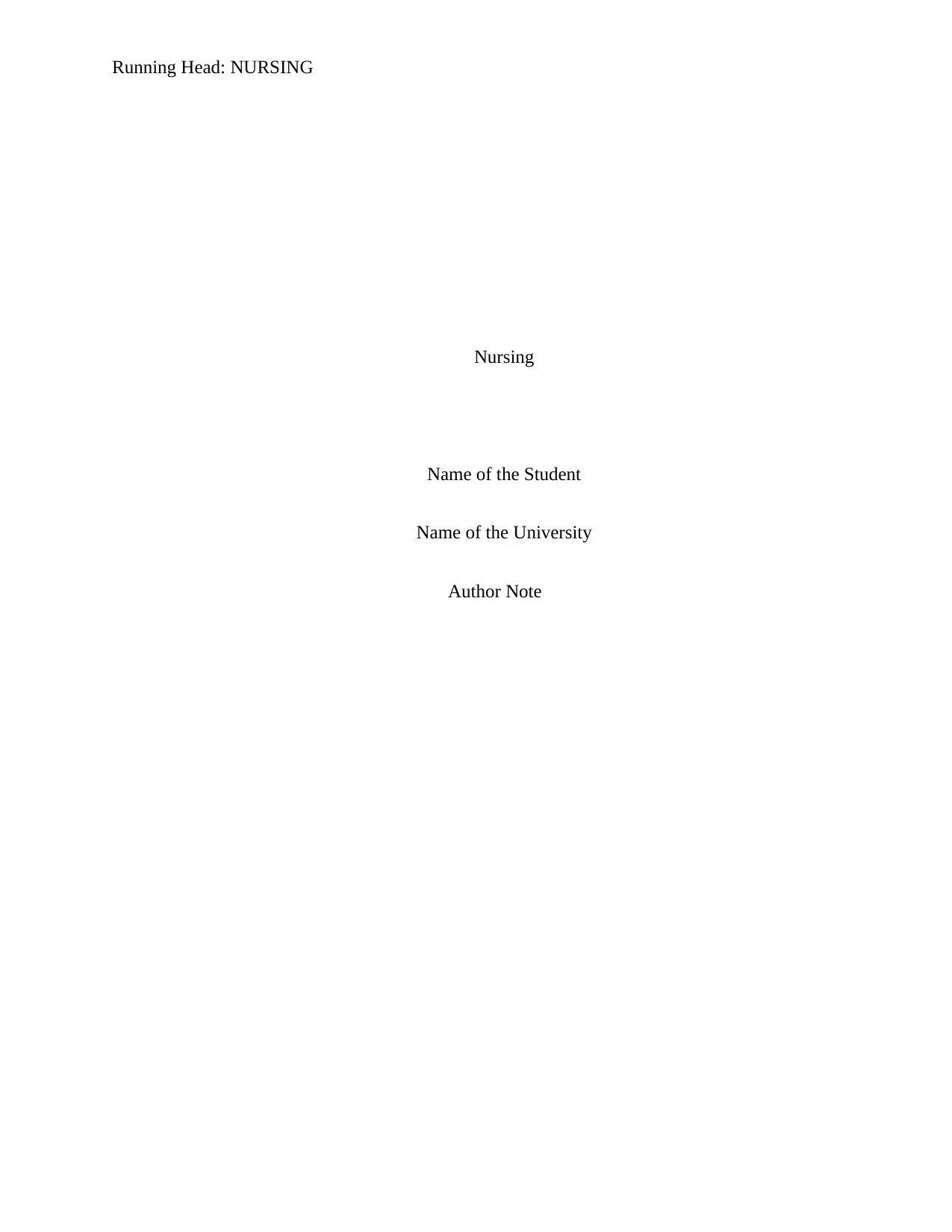
Running Head: NURSING
Nursing
Name of the Student
Name of the University
Author Note
Nursing
Name of the Student
Name of the University
Author Note
Paraphrase This Document
Need a fresh take? Get an instant paraphrase of this document with our AI Paraphraser
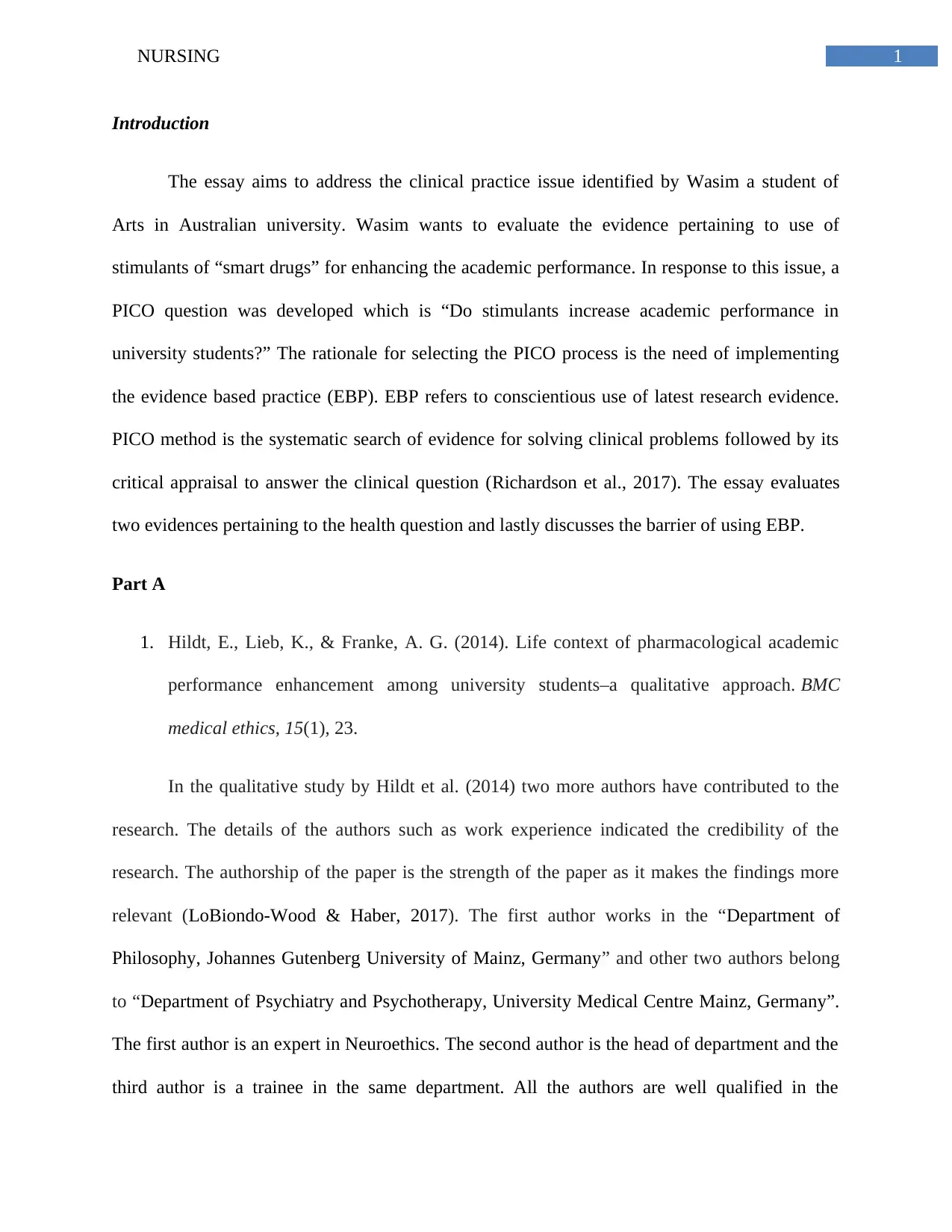
1NURSING
Introduction
The essay aims to address the clinical practice issue identified by Wasim a student of
Arts in Australian university. Wasim wants to evaluate the evidence pertaining to use of
stimulants of “smart drugs” for enhancing the academic performance. In response to this issue, a
PICO question was developed which is “Do stimulants increase academic performance in
university students?” The rationale for selecting the PICO process is the need of implementing
the evidence based practice (EBP). EBP refers to conscientious use of latest research evidence.
PICO method is the systematic search of evidence for solving clinical problems followed by its
critical appraisal to answer the clinical question (Richardson et al., 2017). The essay evaluates
two evidences pertaining to the health question and lastly discusses the barrier of using EBP.
Part A
1. Hildt, E., Lieb, K., & Franke, A. G. (2014). Life context of pharmacological academic
performance enhancement among university students–a qualitative approach. BMC
medical ethics, 15(1), 23.
In the qualitative study by Hildt et al. (2014) two more authors have contributed to the
research. The details of the authors such as work experience indicated the credibility of the
research. The authorship of the paper is the strength of the paper as it makes the findings more
relevant (LoBiondo-Wood & Haber, 2017). The first author works in the “Department of
Philosophy, Johannes Gutenberg University of Mainz, Germany” and other two authors belong
to “Department of Psychiatry and Psychotherapy, University Medical Centre Mainz, Germany”.
The first author is an expert in Neuroethics. The second author is the head of department and the
third author is a trainee in the same department. All the authors are well qualified in the
Introduction
The essay aims to address the clinical practice issue identified by Wasim a student of
Arts in Australian university. Wasim wants to evaluate the evidence pertaining to use of
stimulants of “smart drugs” for enhancing the academic performance. In response to this issue, a
PICO question was developed which is “Do stimulants increase academic performance in
university students?” The rationale for selecting the PICO process is the need of implementing
the evidence based practice (EBP). EBP refers to conscientious use of latest research evidence.
PICO method is the systematic search of evidence for solving clinical problems followed by its
critical appraisal to answer the clinical question (Richardson et al., 2017). The essay evaluates
two evidences pertaining to the health question and lastly discusses the barrier of using EBP.
Part A
1. Hildt, E., Lieb, K., & Franke, A. G. (2014). Life context of pharmacological academic
performance enhancement among university students–a qualitative approach. BMC
medical ethics, 15(1), 23.
In the qualitative study by Hildt et al. (2014) two more authors have contributed to the
research. The details of the authors such as work experience indicated the credibility of the
research. The authorship of the paper is the strength of the paper as it makes the findings more
relevant (LoBiondo-Wood & Haber, 2017). The first author works in the “Department of
Philosophy, Johannes Gutenberg University of Mainz, Germany” and other two authors belong
to “Department of Psychiatry and Psychotherapy, University Medical Centre Mainz, Germany”.
The first author is an expert in Neuroethics. The second author is the head of department and the
third author is a trainee in the same department. All the authors are well qualified in the
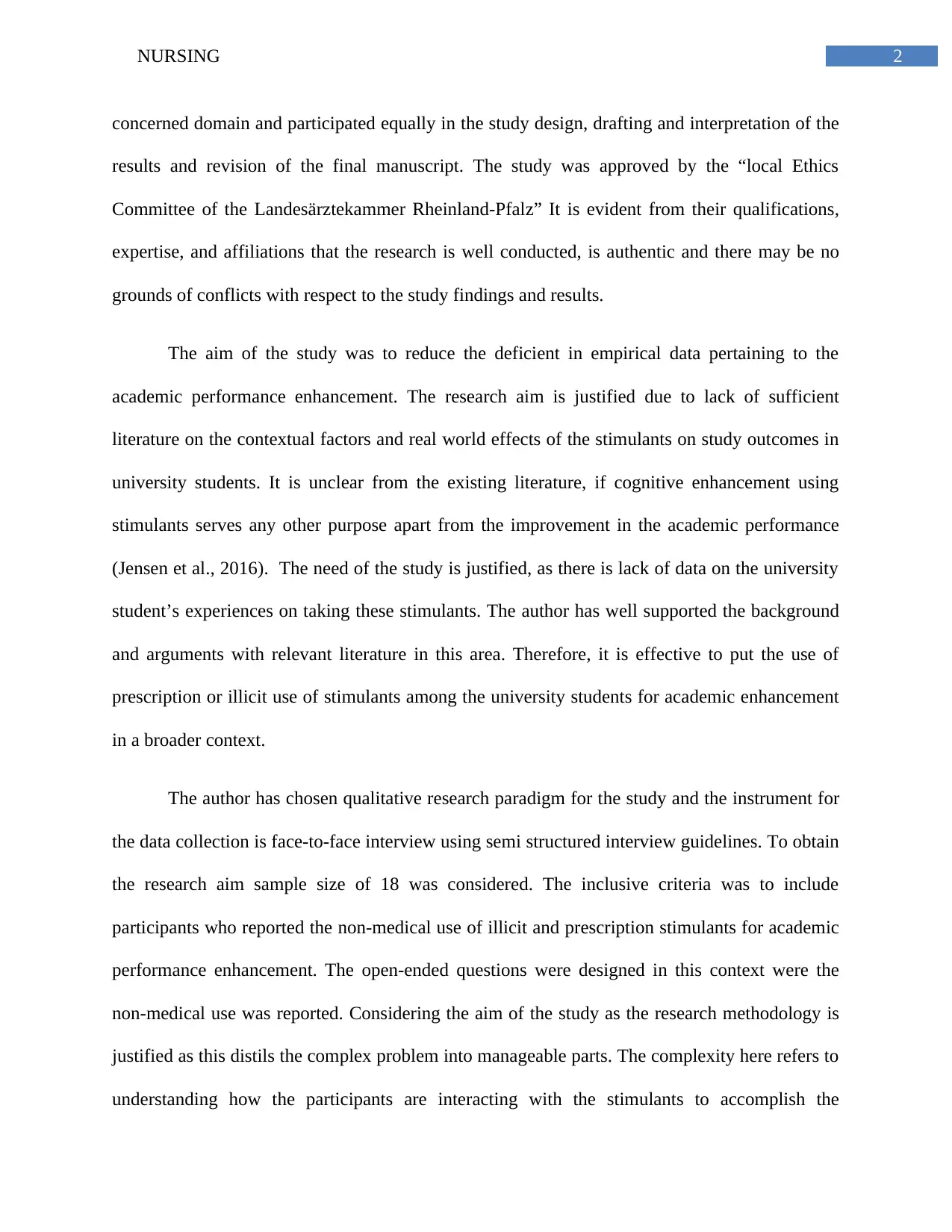
2NURSING
concerned domain and participated equally in the study design, drafting and interpretation of the
results and revision of the final manuscript. The study was approved by the “local Ethics
Committee of the Landesärztekammer Rheinland-Pfalz” It is evident from their qualifications,
expertise, and affiliations that the research is well conducted, is authentic and there may be no
grounds of conflicts with respect to the study findings and results.
The aim of the study was to reduce the deficient in empirical data pertaining to the
academic performance enhancement. The research aim is justified due to lack of sufficient
literature on the contextual factors and real world effects of the stimulants on study outcomes in
university students. It is unclear from the existing literature, if cognitive enhancement using
stimulants serves any other purpose apart from the improvement in the academic performance
(Jensen et al., 2016). The need of the study is justified, as there is lack of data on the university
student’s experiences on taking these stimulants. The author has well supported the background
and arguments with relevant literature in this area. Therefore, it is effective to put the use of
prescription or illicit use of stimulants among the university students for academic enhancement
in a broader context.
The author has chosen qualitative research paradigm for the study and the instrument for
the data collection is face-to-face interview using semi structured interview guidelines. To obtain
the research aim sample size of 18 was considered. The inclusive criteria was to include
participants who reported the non-medical use of illicit and prescription stimulants for academic
performance enhancement. The open-ended questions were designed in this context were the
non-medical use was reported. Considering the aim of the study as the research methodology is
justified as this distils the complex problem into manageable parts. The complexity here refers to
understanding how the participants are interacting with the stimulants to accomplish the
concerned domain and participated equally in the study design, drafting and interpretation of the
results and revision of the final manuscript. The study was approved by the “local Ethics
Committee of the Landesärztekammer Rheinland-Pfalz” It is evident from their qualifications,
expertise, and affiliations that the research is well conducted, is authentic and there may be no
grounds of conflicts with respect to the study findings and results.
The aim of the study was to reduce the deficient in empirical data pertaining to the
academic performance enhancement. The research aim is justified due to lack of sufficient
literature on the contextual factors and real world effects of the stimulants on study outcomes in
university students. It is unclear from the existing literature, if cognitive enhancement using
stimulants serves any other purpose apart from the improvement in the academic performance
(Jensen et al., 2016). The need of the study is justified, as there is lack of data on the university
student’s experiences on taking these stimulants. The author has well supported the background
and arguments with relevant literature in this area. Therefore, it is effective to put the use of
prescription or illicit use of stimulants among the university students for academic enhancement
in a broader context.
The author has chosen qualitative research paradigm for the study and the instrument for
the data collection is face-to-face interview using semi structured interview guidelines. To obtain
the research aim sample size of 18 was considered. The inclusive criteria was to include
participants who reported the non-medical use of illicit and prescription stimulants for academic
performance enhancement. The open-ended questions were designed in this context were the
non-medical use was reported. Considering the aim of the study as the research methodology is
justified as this distils the complex problem into manageable parts. The complexity here refers to
understanding how the participants are interacting with the stimulants to accomplish the
⊘ This is a preview!⊘
Do you want full access?
Subscribe today to unlock all pages.

Trusted by 1+ million students worldwide
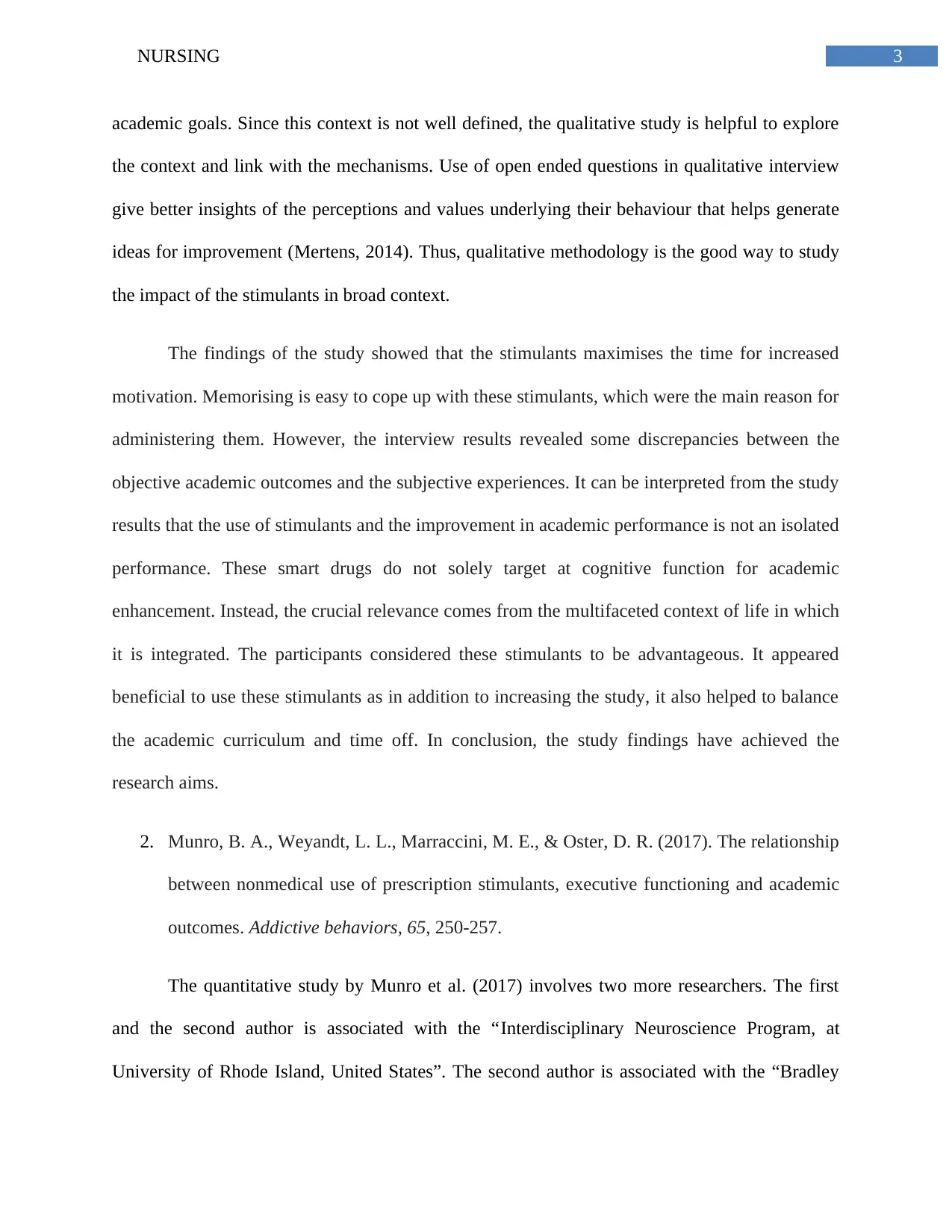
3NURSING
academic goals. Since this context is not well defined, the qualitative study is helpful to explore
the context and link with the mechanisms. Use of open ended questions in qualitative interview
give better insights of the perceptions and values underlying their behaviour that helps generate
ideas for improvement (Mertens, 2014). Thus, qualitative methodology is the good way to study
the impact of the stimulants in broad context.
The findings of the study showed that the stimulants maximises the time for increased
motivation. Memorising is easy to cope up with these stimulants, which were the main reason for
administering them. However, the interview results revealed some discrepancies between the
objective academic outcomes and the subjective experiences. It can be interpreted from the study
results that the use of stimulants and the improvement in academic performance is not an isolated
performance. These smart drugs do not solely target at cognitive function for academic
enhancement. Instead, the crucial relevance comes from the multifaceted context of life in which
it is integrated. The participants considered these stimulants to be advantageous. It appeared
beneficial to use these stimulants as in addition to increasing the study, it also helped to balance
the academic curriculum and time off. In conclusion, the study findings have achieved the
research aims.
2. Munro, B. A., Weyandt, L. L., Marraccini, M. E., & Oster, D. R. (2017). The relationship
between nonmedical use of prescription stimulants, executive functioning and academic
outcomes. Addictive behaviors, 65, 250-257.
The quantitative study by Munro et al. (2017) involves two more researchers. The first
and the second author is associated with the “Interdisciplinary Neuroscience Program, at
University of Rhode Island, United States”. The second author is associated with the “Bradley
academic goals. Since this context is not well defined, the qualitative study is helpful to explore
the context and link with the mechanisms. Use of open ended questions in qualitative interview
give better insights of the perceptions and values underlying their behaviour that helps generate
ideas for improvement (Mertens, 2014). Thus, qualitative methodology is the good way to study
the impact of the stimulants in broad context.
The findings of the study showed that the stimulants maximises the time for increased
motivation. Memorising is easy to cope up with these stimulants, which were the main reason for
administering them. However, the interview results revealed some discrepancies between the
objective academic outcomes and the subjective experiences. It can be interpreted from the study
results that the use of stimulants and the improvement in academic performance is not an isolated
performance. These smart drugs do not solely target at cognitive function for academic
enhancement. Instead, the crucial relevance comes from the multifaceted context of life in which
it is integrated. The participants considered these stimulants to be advantageous. It appeared
beneficial to use these stimulants as in addition to increasing the study, it also helped to balance
the academic curriculum and time off. In conclusion, the study findings have achieved the
research aims.
2. Munro, B. A., Weyandt, L. L., Marraccini, M. E., & Oster, D. R. (2017). The relationship
between nonmedical use of prescription stimulants, executive functioning and academic
outcomes. Addictive behaviors, 65, 250-257.
The quantitative study by Munro et al. (2017) involves two more researchers. The first
and the second author is associated with the “Interdisciplinary Neuroscience Program, at
University of Rhode Island, United States”. The second author is associated with the “Bradley
Paraphrase This Document
Need a fresh take? Get an instant paraphrase of this document with our AI Paraphraser
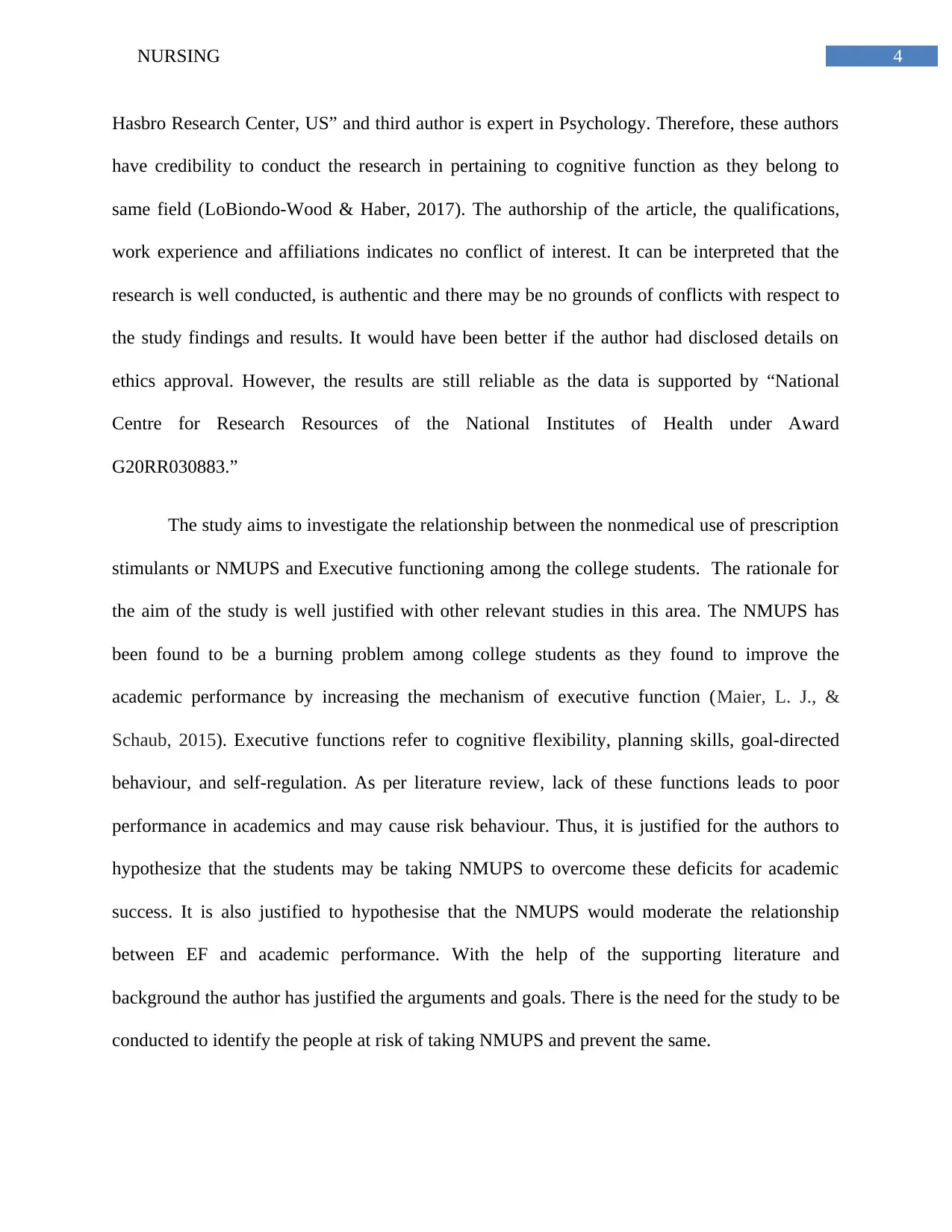
4NURSING
Hasbro Research Center, US” and third author is expert in Psychology. Therefore, these authors
have credibility to conduct the research in pertaining to cognitive function as they belong to
same field (LoBiondo-Wood & Haber, 2017). The authorship of the article, the qualifications,
work experience and affiliations indicates no conflict of interest. It can be interpreted that the
research is well conducted, is authentic and there may be no grounds of conflicts with respect to
the study findings and results. It would have been better if the author had disclosed details on
ethics approval. However, the results are still reliable as the data is supported by “National
Centre for Research Resources of the National Institutes of Health under Award
G20RR030883.”
The study aims to investigate the relationship between the nonmedical use of prescription
stimulants or NMUPS and Executive functioning among the college students. The rationale for
the aim of the study is well justified with other relevant studies in this area. The NMUPS has
been found to be a burning problem among college students as they found to improve the
academic performance by increasing the mechanism of executive function (Maier, L. J., &
Schaub, 2015). Executive functions refer to cognitive flexibility, planning skills, goal-directed
behaviour, and self-regulation. As per literature review, lack of these functions leads to poor
performance in academics and may cause risk behaviour. Thus, it is justified for the authors to
hypothesize that the students may be taking NMUPS to overcome these deficits for academic
success. It is also justified to hypothesise that the NMUPS would moderate the relationship
between EF and academic performance. With the help of the supporting literature and
background the author has justified the arguments and goals. There is the need for the study to be
conducted to identify the people at risk of taking NMUPS and prevent the same.
Hasbro Research Center, US” and third author is expert in Psychology. Therefore, these authors
have credibility to conduct the research in pertaining to cognitive function as they belong to
same field (LoBiondo-Wood & Haber, 2017). The authorship of the article, the qualifications,
work experience and affiliations indicates no conflict of interest. It can be interpreted that the
research is well conducted, is authentic and there may be no grounds of conflicts with respect to
the study findings and results. It would have been better if the author had disclosed details on
ethics approval. However, the results are still reliable as the data is supported by “National
Centre for Research Resources of the National Institutes of Health under Award
G20RR030883.”
The study aims to investigate the relationship between the nonmedical use of prescription
stimulants or NMUPS and Executive functioning among the college students. The rationale for
the aim of the study is well justified with other relevant studies in this area. The NMUPS has
been found to be a burning problem among college students as they found to improve the
academic performance by increasing the mechanism of executive function (Maier, L. J., &
Schaub, 2015). Executive functions refer to cognitive flexibility, planning skills, goal-directed
behaviour, and self-regulation. As per literature review, lack of these functions leads to poor
performance in academics and may cause risk behaviour. Thus, it is justified for the authors to
hypothesize that the students may be taking NMUPS to overcome these deficits for academic
success. It is also justified to hypothesise that the NMUPS would moderate the relationship
between EF and academic performance. With the help of the supporting literature and
background the author has justified the arguments and goals. There is the need for the study to be
conducted to identify the people at risk of taking NMUPS and prevent the same.
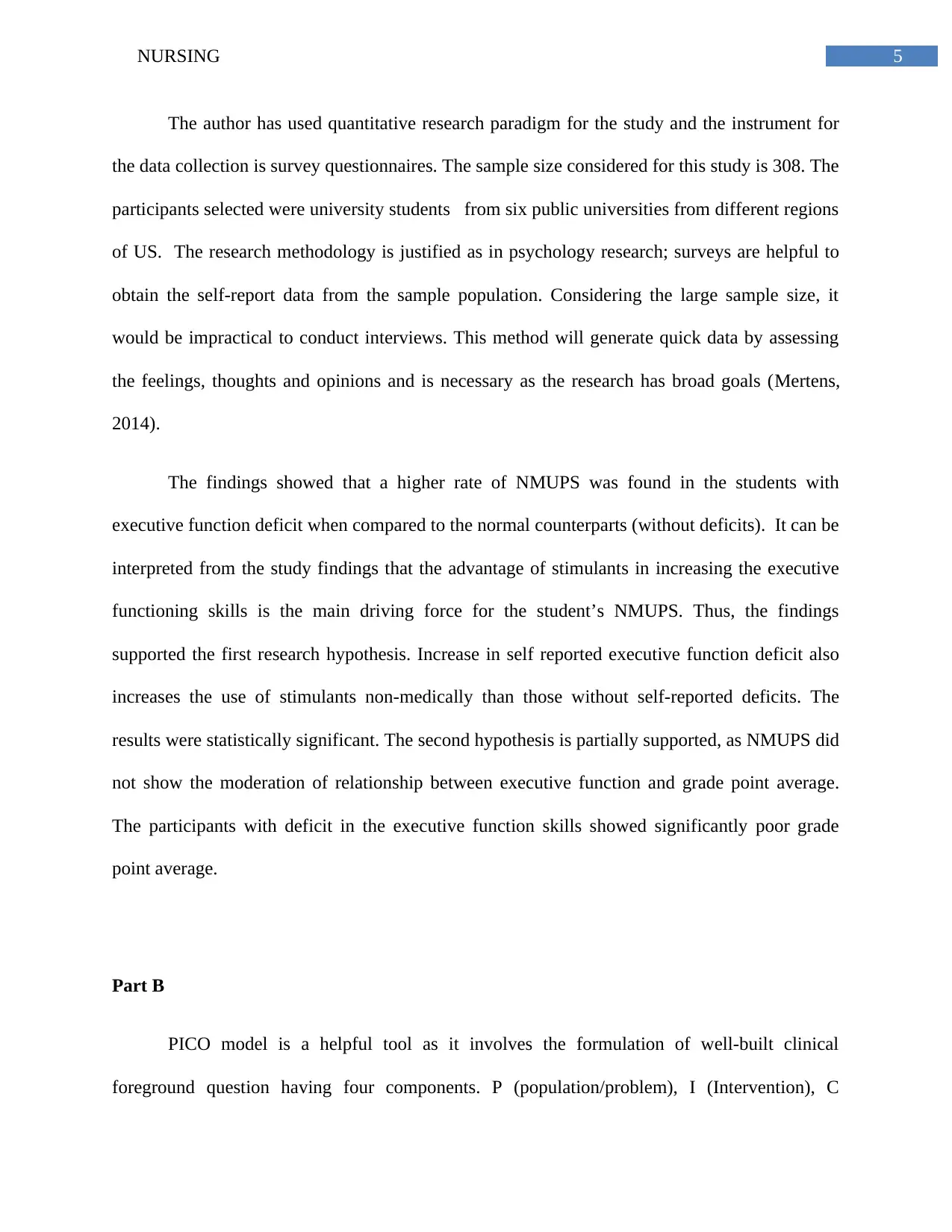
5NURSING
The author has used quantitative research paradigm for the study and the instrument for
the data collection is survey questionnaires. The sample size considered for this study is 308. The
participants selected were university students from six public universities from different regions
of US. The research methodology is justified as in psychology research; surveys are helpful to
obtain the self-report data from the sample population. Considering the large sample size, it
would be impractical to conduct interviews. This method will generate quick data by assessing
the feelings, thoughts and opinions and is necessary as the research has broad goals (Mertens,
2014).
The findings showed that a higher rate of NMUPS was found in the students with
executive function deficit when compared to the normal counterparts (without deficits). It can be
interpreted from the study findings that the advantage of stimulants in increasing the executive
functioning skills is the main driving force for the student’s NMUPS. Thus, the findings
supported the first research hypothesis. Increase in self reported executive function deficit also
increases the use of stimulants non-medically than those without self-reported deficits. The
results were statistically significant. The second hypothesis is partially supported, as NMUPS did
not show the moderation of relationship between executive function and grade point average.
The participants with deficit in the executive function skills showed significantly poor grade
point average.
Part B
PICO model is a helpful tool as it involves the formulation of well-built clinical
foreground question having four components. P (population/problem), I (Intervention), C
The author has used quantitative research paradigm for the study and the instrument for
the data collection is survey questionnaires. The sample size considered for this study is 308. The
participants selected were university students from six public universities from different regions
of US. The research methodology is justified as in psychology research; surveys are helpful to
obtain the self-report data from the sample population. Considering the large sample size, it
would be impractical to conduct interviews. This method will generate quick data by assessing
the feelings, thoughts and opinions and is necessary as the research has broad goals (Mertens,
2014).
The findings showed that a higher rate of NMUPS was found in the students with
executive function deficit when compared to the normal counterparts (without deficits). It can be
interpreted from the study findings that the advantage of stimulants in increasing the executive
functioning skills is the main driving force for the student’s NMUPS. Thus, the findings
supported the first research hypothesis. Increase in self reported executive function deficit also
increases the use of stimulants non-medically than those without self-reported deficits. The
results were statistically significant. The second hypothesis is partially supported, as NMUPS did
not show the moderation of relationship between executive function and grade point average.
The participants with deficit in the executive function skills showed significantly poor grade
point average.
Part B
PICO model is a helpful tool as it involves the formulation of well-built clinical
foreground question having four components. P (population/problem), I (Intervention), C
⊘ This is a preview!⊘
Do you want full access?
Subscribe today to unlock all pages.

Trusted by 1+ million students worldwide
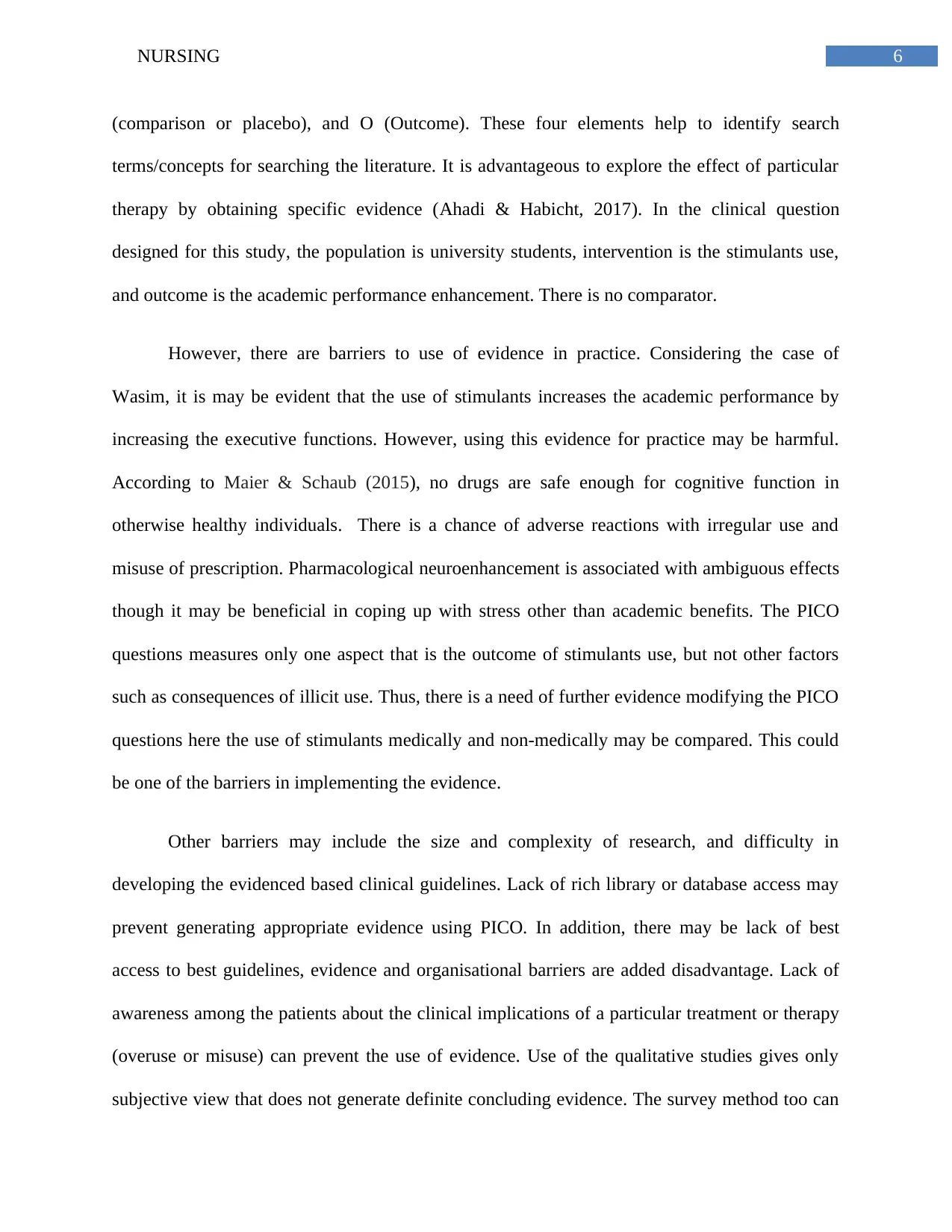
6NURSING
(comparison or placebo), and O (Outcome). These four elements help to identify search
terms/concepts for searching the literature. It is advantageous to explore the effect of particular
therapy by obtaining specific evidence (Ahadi & Habicht, 2017). In the clinical question
designed for this study, the population is university students, intervention is the stimulants use,
and outcome is the academic performance enhancement. There is no comparator.
However, there are barriers to use of evidence in practice. Considering the case of
Wasim, it is may be evident that the use of stimulants increases the academic performance by
increasing the executive functions. However, using this evidence for practice may be harmful.
According to Maier & Schaub (2015), no drugs are safe enough for cognitive function in
otherwise healthy individuals. There is a chance of adverse reactions with irregular use and
misuse of prescription. Pharmacological neuroenhancement is associated with ambiguous effects
though it may be beneficial in coping up with stress other than academic benefits. The PICO
questions measures only one aspect that is the outcome of stimulants use, but not other factors
such as consequences of illicit use. Thus, there is a need of further evidence modifying the PICO
questions here the use of stimulants medically and non-medically may be compared. This could
be one of the barriers in implementing the evidence.
Other barriers may include the size and complexity of research, and difficulty in
developing the evidenced based clinical guidelines. Lack of rich library or database access may
prevent generating appropriate evidence using PICO. In addition, there may be lack of best
access to best guidelines, evidence and organisational barriers are added disadvantage. Lack of
awareness among the patients about the clinical implications of a particular treatment or therapy
(overuse or misuse) can prevent the use of evidence. Use of the qualitative studies gives only
subjective view that does not generate definite concluding evidence. The survey method too can
(comparison or placebo), and O (Outcome). These four elements help to identify search
terms/concepts for searching the literature. It is advantageous to explore the effect of particular
therapy by obtaining specific evidence (Ahadi & Habicht, 2017). In the clinical question
designed for this study, the population is university students, intervention is the stimulants use,
and outcome is the academic performance enhancement. There is no comparator.
However, there are barriers to use of evidence in practice. Considering the case of
Wasim, it is may be evident that the use of stimulants increases the academic performance by
increasing the executive functions. However, using this evidence for practice may be harmful.
According to Maier & Schaub (2015), no drugs are safe enough for cognitive function in
otherwise healthy individuals. There is a chance of adverse reactions with irregular use and
misuse of prescription. Pharmacological neuroenhancement is associated with ambiguous effects
though it may be beneficial in coping up with stress other than academic benefits. The PICO
questions measures only one aspect that is the outcome of stimulants use, but not other factors
such as consequences of illicit use. Thus, there is a need of further evidence modifying the PICO
questions here the use of stimulants medically and non-medically may be compared. This could
be one of the barriers in implementing the evidence.
Other barriers may include the size and complexity of research, and difficulty in
developing the evidenced based clinical guidelines. Lack of rich library or database access may
prevent generating appropriate evidence using PICO. In addition, there may be lack of best
access to best guidelines, evidence and organisational barriers are added disadvantage. Lack of
awareness among the patients about the clinical implications of a particular treatment or therapy
(overuse or misuse) can prevent the use of evidence. Use of the qualitative studies gives only
subjective view that does not generate definite concluding evidence. The survey method too can
Paraphrase This Document
Need a fresh take? Get an instant paraphrase of this document with our AI Paraphraser
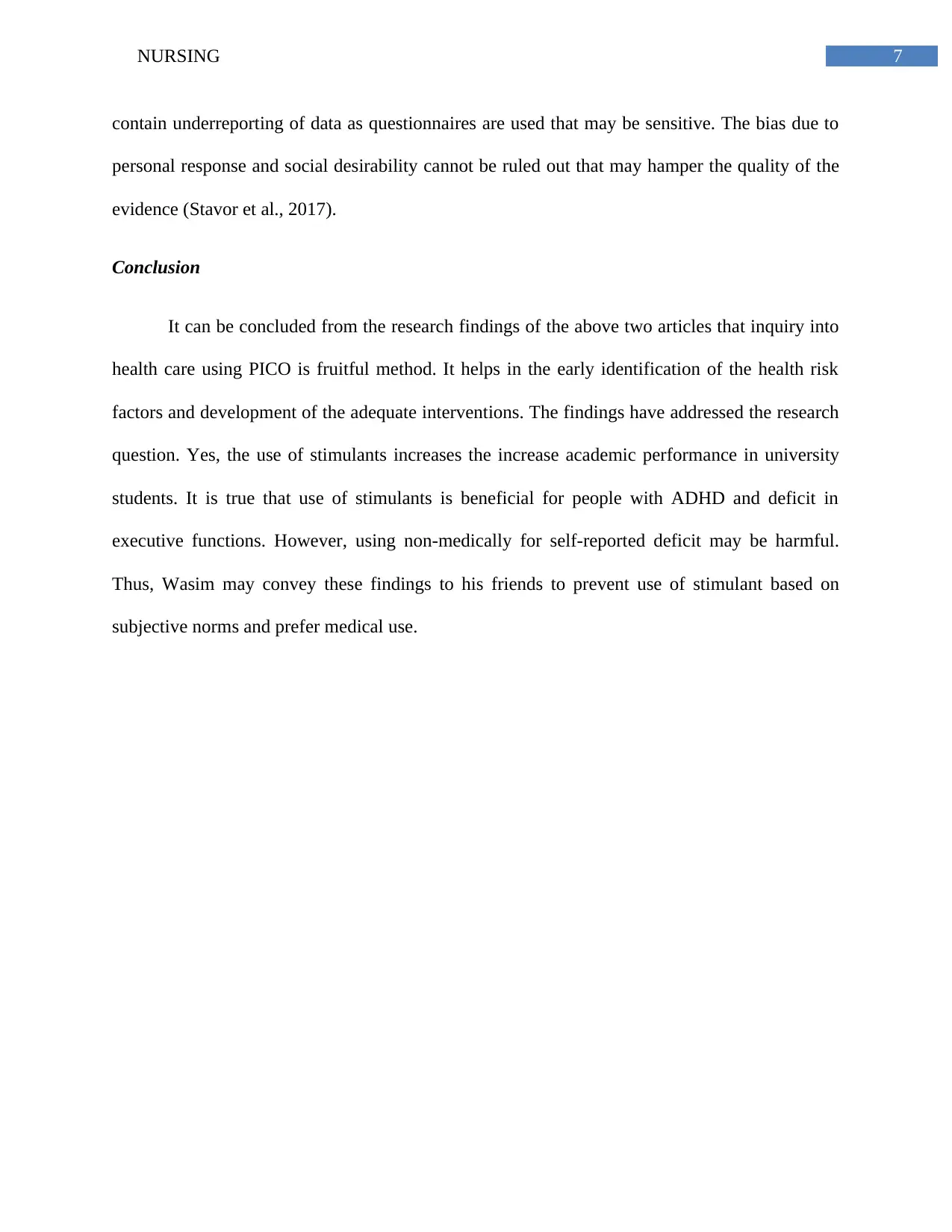
7NURSING
contain underreporting of data as questionnaires are used that may be sensitive. The bias due to
personal response and social desirability cannot be ruled out that may hamper the quality of the
evidence (Stavor et al., 2017).
Conclusion
It can be concluded from the research findings of the above two articles that inquiry into
health care using PICO is fruitful method. It helps in the early identification of the health risk
factors and development of the adequate interventions. The findings have addressed the research
question. Yes, the use of stimulants increases the increase academic performance in university
students. It is true that use of stimulants is beneficial for people with ADHD and deficit in
executive functions. However, using non-medically for self-reported deficit may be harmful.
Thus, Wasim may convey these findings to his friends to prevent use of stimulant based on
subjective norms and prefer medical use.
contain underreporting of data as questionnaires are used that may be sensitive. The bias due to
personal response and social desirability cannot be ruled out that may hamper the quality of the
evidence (Stavor et al., 2017).
Conclusion
It can be concluded from the research findings of the above two articles that inquiry into
health care using PICO is fruitful method. It helps in the early identification of the health risk
factors and development of the adequate interventions. The findings have addressed the research
question. Yes, the use of stimulants increases the increase academic performance in university
students. It is true that use of stimulants is beneficial for people with ADHD and deficit in
executive functions. However, using non-medically for self-reported deficit may be harmful.
Thus, Wasim may convey these findings to his friends to prevent use of stimulant based on
subjective norms and prefer medical use.
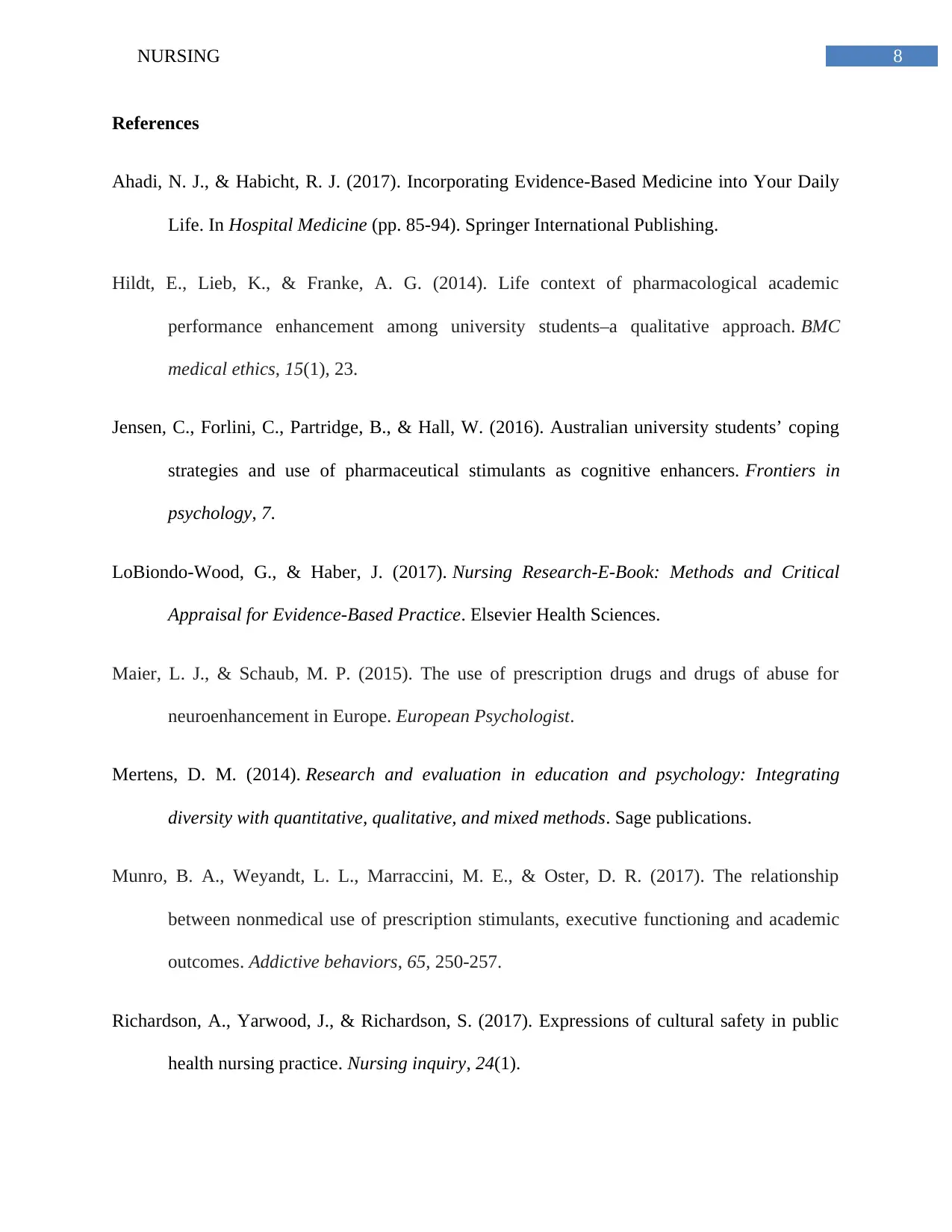
8NURSING
References
Ahadi, N. J., & Habicht, R. J. (2017). Incorporating Evidence-Based Medicine into Your Daily
Life. In Hospital Medicine (pp. 85-94). Springer International Publishing.
Hildt, E., Lieb, K., & Franke, A. G. (2014). Life context of pharmacological academic
performance enhancement among university students–a qualitative approach. BMC
medical ethics, 15(1), 23.
Jensen, C., Forlini, C., Partridge, B., & Hall, W. (2016). Australian university students’ coping
strategies and use of pharmaceutical stimulants as cognitive enhancers. Frontiers in
psychology, 7.
LoBiondo-Wood, G., & Haber, J. (2017). Nursing Research-E-Book: Methods and Critical
Appraisal for Evidence-Based Practice. Elsevier Health Sciences.
Maier, L. J., & Schaub, M. P. (2015). The use of prescription drugs and drugs of abuse for
neuroenhancement in Europe. European Psychologist.
Mertens, D. M. (2014). Research and evaluation in education and psychology: Integrating
diversity with quantitative, qualitative, and mixed methods. Sage publications.
Munro, B. A., Weyandt, L. L., Marraccini, M. E., & Oster, D. R. (2017). The relationship
between nonmedical use of prescription stimulants, executive functioning and academic
outcomes. Addictive behaviors, 65, 250-257.
Richardson, A., Yarwood, J., & Richardson, S. (2017). Expressions of cultural safety in public
health nursing practice. Nursing inquiry, 24(1).
References
Ahadi, N. J., & Habicht, R. J. (2017). Incorporating Evidence-Based Medicine into Your Daily
Life. In Hospital Medicine (pp. 85-94). Springer International Publishing.
Hildt, E., Lieb, K., & Franke, A. G. (2014). Life context of pharmacological academic
performance enhancement among university students–a qualitative approach. BMC
medical ethics, 15(1), 23.
Jensen, C., Forlini, C., Partridge, B., & Hall, W. (2016). Australian university students’ coping
strategies and use of pharmaceutical stimulants as cognitive enhancers. Frontiers in
psychology, 7.
LoBiondo-Wood, G., & Haber, J. (2017). Nursing Research-E-Book: Methods and Critical
Appraisal for Evidence-Based Practice. Elsevier Health Sciences.
Maier, L. J., & Schaub, M. P. (2015). The use of prescription drugs and drugs of abuse for
neuroenhancement in Europe. European Psychologist.
Mertens, D. M. (2014). Research and evaluation in education and psychology: Integrating
diversity with quantitative, qualitative, and mixed methods. Sage publications.
Munro, B. A., Weyandt, L. L., Marraccini, M. E., & Oster, D. R. (2017). The relationship
between nonmedical use of prescription stimulants, executive functioning and academic
outcomes. Addictive behaviors, 65, 250-257.
Richardson, A., Yarwood, J., & Richardson, S. (2017). Expressions of cultural safety in public
health nursing practice. Nursing inquiry, 24(1).
⊘ This is a preview!⊘
Do you want full access?
Subscribe today to unlock all pages.

Trusted by 1+ million students worldwide
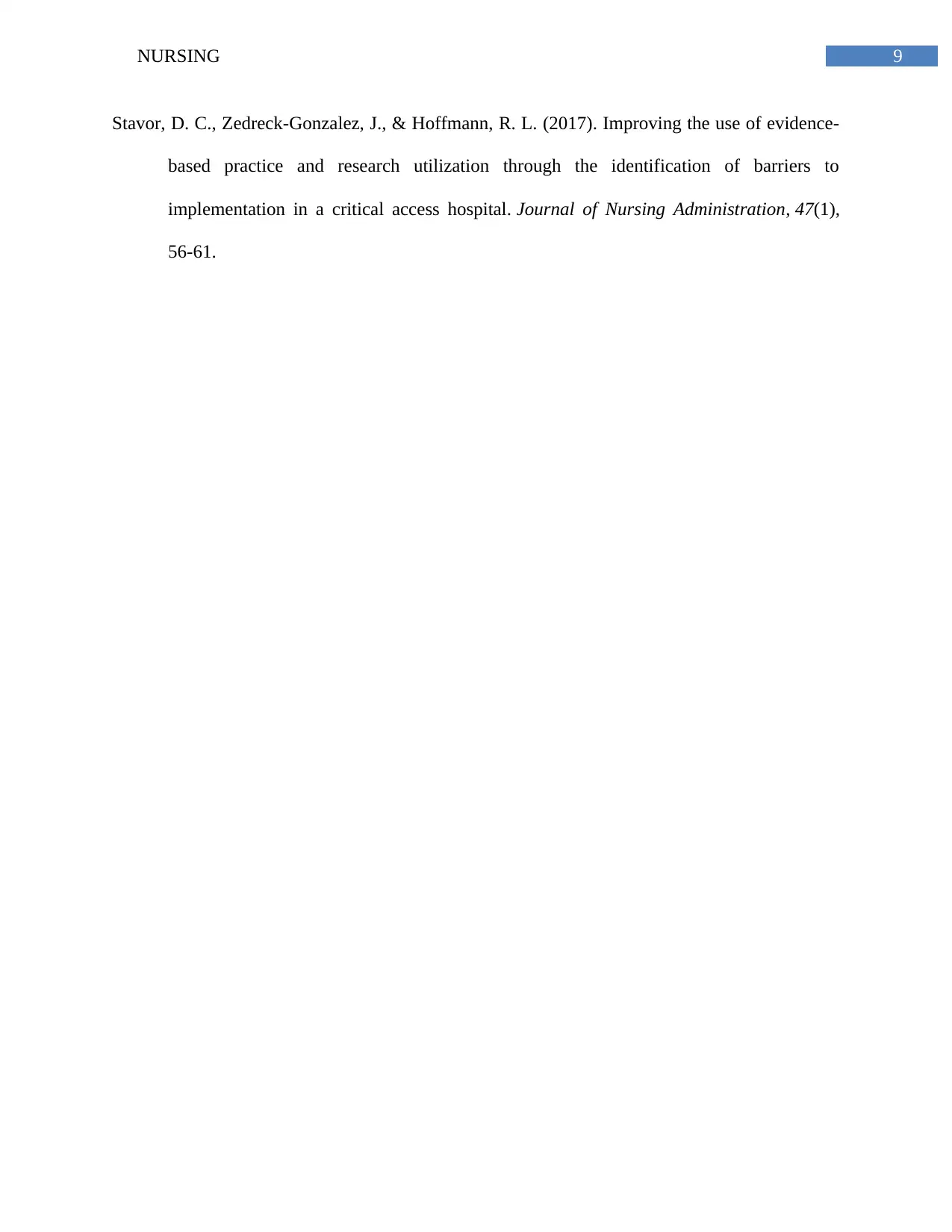
9NURSING
Stavor, D. C., Zedreck-Gonzalez, J., & Hoffmann, R. L. (2017). Improving the use of evidence-
based practice and research utilization through the identification of barriers to
implementation in a critical access hospital. Journal of Nursing Administration, 47(1),
56-61.
Stavor, D. C., Zedreck-Gonzalez, J., & Hoffmann, R. L. (2017). Improving the use of evidence-
based practice and research utilization through the identification of barriers to
implementation in a critical access hospital. Journal of Nursing Administration, 47(1),
56-61.
1 out of 10
Related Documents
Your All-in-One AI-Powered Toolkit for Academic Success.
+13062052269
info@desklib.com
Available 24*7 on WhatsApp / Email
![[object Object]](/_next/static/media/star-bottom.7253800d.svg)
Unlock your academic potential
Copyright © 2020–2025 A2Z Services. All Rights Reserved. Developed and managed by ZUCOL.





